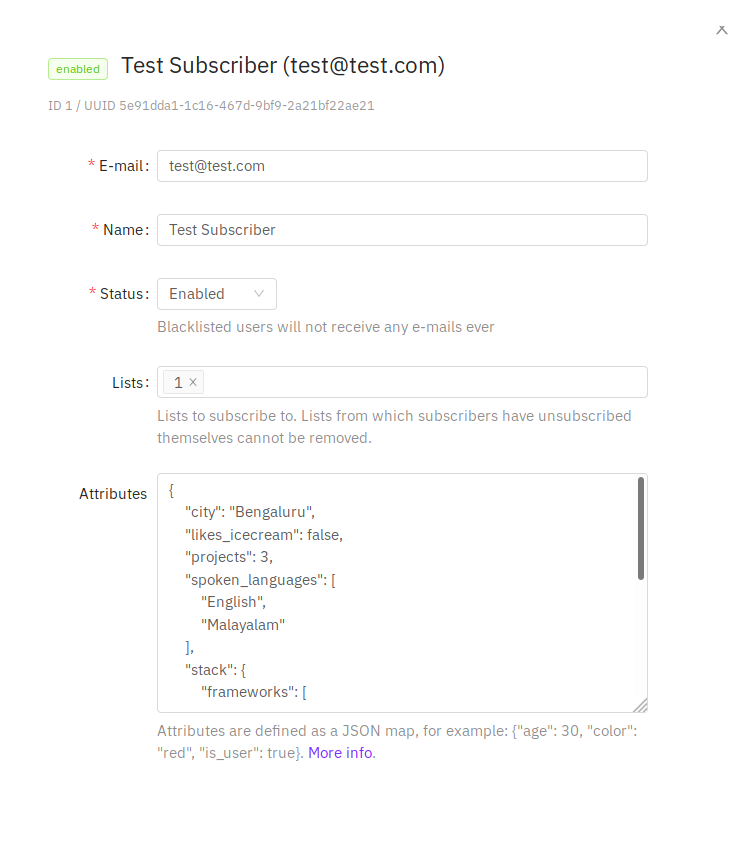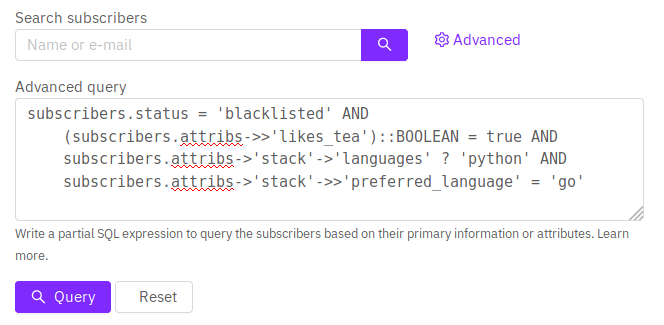Querying and segmenting subscribers¶
listmonk allows the writing of partial Postgres SQL expressions to query, filter, and segment subscribers.
Database fields¶
These are the fields in the subscriber database that can be queried.
| Field | Description |
|---|---|
subscribers.uuid |
The randomly generated unique ID of the subscriber |
subscribers.email |
E-mail ID of the subscriber |
subscribers.name |
Name of the subscriber |
subscribers.status |
Status of the subscriber (enabled, disabled, blocklisted) |
subscribers.attribs |
Map of arbitrary attributes represented as JSON. Accessed via the -> and ->> Postgres operator. |
subscribers.created_at |
Timestamp when the subscriber was first added |
subscribers.updated_at |
Timestamp when the subscriber was modified |
Sample attributes¶
Here's a sample JSON map of attributes assigned to an imaginary subscriber.
{
"city": "Bengaluru",
"likes_tea": true,
"spoken_languages": ["English", "Malayalam"],
"projects": 3,
"stack": {
"frameworks": ["echo", "go"],
"languages": ["go", "python"],
"preferred_language": "go"
}
}

Sample SQL query expressions¶

Find a subscriber by e-mail¶
-- Exact match
subscribers.email = 'some@domain.com'
-- Partial match to find e-mails that end in @domain.com.
subscribers.email LIKE '%@domain.com'
Find a subscriber by name¶
-- Find all subscribers whose name start with John.
subscribers.email LIKE 'John%'
Multiple conditions¶
-- Find all Johns who have been blocklisted.
subscribers.email LIKE 'John%' AND status = 'blocklisted'
Querying subscribers who viewed the campaign email¶
-- Find all subscribers who viewed the campaign email.
EXISTS(SELECT 1 FROM campaign_views WHERE campaign_views.subscriber_id=subscribers.id AND campaign_views.campaign_id=<put_id_of_campaign>)
Querying attributes¶
-- The ->> operator returns the value as text. Find all subscribers
-- who live in Bengaluru and have done more than 3 projects.
-- Here 'projects' is cast into an integer so that we can apply the
-- numerical operator >
subscribers.attribs->>'city' = 'Bengaluru' AND
(subscribers.attribs->>'projects')::INT > 3
Querying nested attributes¶
-- Find all blocklisted subscribers who like to drink tea, can code Python
-- and prefer coding Go.
--
-- The -> operator returns the value as a structure. Here, the "languages" field
-- The ? operator checks for the existence of a value in a list.
subscribers.status = 'blocklisted' AND
(subscribers.attribs->>'likes_tea')::BOOLEAN = true AND
subscribers.attribs->'stack'->'languages' ? 'python' AND
subscribers.attribs->'stack'->>'preferred_language' = 'go'
To learn how to write SQL expressions to do advancd querying on JSON attributes, refer to the Postgres JSONB documentation.